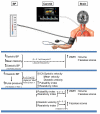Blood pressure, internal carotid artery flow parameters, and age-related white matter hyperintensities
- PMID: 24470459
- PMCID: PMC3984108
- DOI: 10.1161/HYPERTENSIONAHA.113.02735
Blood pressure, internal carotid artery flow parameters, and age-related white matter hyperintensities
Abstract
White matter hyperintensities (WMH) are associated with hypertension. We examined interactions among blood pressure (BP), internal carotid artery (ICA) flow velocity parameters, and WMH. We obtained BP measurements from 694 community-dwelling subjects at mean ages 69.6 (±0.8) years and again at 72.6 (±0.7) years, plus brain MRI and ICA ultrasound at age 73±1 years. Diastolic and mean BP decreased and pulse pressure increased, but systolic BP did not change between 70 and 73 years. Multiple linear regression, corrected for vascular disease and risk factors, showed that WMH at the age of 73 years were associated with history of hypertension (β=0.13; P<0.001) and with BP at the age of 70 years (systolic β=0.08, mean β=0.09, diastolic β=0.08; all P<0.05); similar but attenuated associations were seen for BP at the age of 73 years. Lower diastolic BP and higher pulse pressure were associated with higher ICA pulsatility index at the age 73 years (diastolic BP age 70 years: standardized β=-0.24, P<0.001; pulse pressure age 70 years: β=0.19, P<0.001). WMH were associated with higher ICA pulsatility index (β=0.13; P=0.002) after adjusting for BP and correction for multiple testing. Therefore, falling diastolic BP and increased pulse pressure are associated with increased ICA pulsatility index, which in turn is associated with WMH. This suggests that hypertension and WMH may either associate indirectly because hypertension increases arterial stiffness that leads to WMH over time, or coassociate through advancing age and stiffer vessels, or both. Reducing vascular stiffness may reduce WMH progression and should be tested in randomized trials, in addition to testing antihypertensive therapy.
Keywords: aging; blood flow velocity; blood pressure; cerebrovascular disorders; magnetic resonance imaging.
Figures

References
-
- Wardlaw JM, Smith EE, Biessels GJ, Cordonnier C, Fazekas F, Frayne R, Lindley RI, O’Brien JT, Barkhof F, Benavente OR, Black S, Brayne C, Breteler M, Chabriat H, DeCarli C, de Leeuw F-E, Doubal F, Duering M, Fox N, Greenberg S, Hachinski V, Kilimann I, Mok V, van Oostengbrugge R, Pantoni L, Speck O, Stephan BC, Teipel S, Viswanathan A, Werring D, Chen C, Smith C, van Buchem M, Norrving B, Gorelick PB, Dichgans M. Neuroimaging standards for research into small vessel disease and its contribution to ageing and neurodegeneration. Lancet Neurol. 2013;12:822–838. - PMC - PubMed
-
- O’Rourke MF, Hashimoto J. Mechanical factors in arterial aging: a clinical perspective. J Am Coll Cardiol. 2007;50:1–13. - PubMed
-
- Shrestha I, Takahashi T, Nomura E, Ohtsuki T, Ohshita T, Ueno H, Kohriyama T, Matsumoto M. Association between central systolic blood pressure, white matter lesions in cerebral MRI and carotid atherosclerosis. Hypertens Res. 2009;32:869–874. - PubMed
-
- Xu TY, Staessen JA, Wei FF, Xu J, Li FH, Fan WX, Gao PJ, Wang JG, Li Y. Blood flow pattern in the middle cerebral artery in relation to indices of arterial stiffness in the systemic circulation. Am J Hypertens. 2012;25:319–324. - PubMed
Publication types
MeSH terms
Grants and funding
- G1001245/MRC_/Medical Research Council/United Kingdom
- MR/K026992/1/MRC_/Medical Research Council/United Kingdom
- G0701120/MRC_/Medical Research Council/United Kingdom
- G0700704/MRC_/Medical Research Council/United Kingdom
- G0700704/84698/BB_/Biotechnology and Biological Sciences Research Council/United Kingdom
LinkOut - more resources
Full Text Sources
Other Literature Sources
Medical
Miscellaneous

